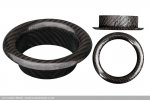Ford Mechanic
Active member
- 1,805
- 10
- 38
- Location
- Edenton, NC
Steel Soldiers now has a few new forums, read more about it at: New Munitions Forums!

 fire when ready.
fire when ready.
HP / VE is directly related to CFM - I've actually never seen someone make your claim before, physics is against you.Horsepower has nothing to do with air flow, however airflow and restrictions/turbulance have everything to do with horsepower. RPM and cubic inches are just 2 of the many things to be concidered when dealing with cfm requirements of an engine. Example: You have 2 engines one is 400 cubic inches and makes 400 hp at 5,000 rpm. The other one is 800 cubic inches and makes 400 hp at 2,500 rpm assuming cfm flow to cubic inch ratio flows are the same between engines the 800 incher will need more air flow to match the 400 incher due to the differences in port diameter and air speed requirements.

I actually just had mine delivered to me up here in North Dakota, to the rig I'm on. It'll be awhile before I can leave the rig to get to a town to track down an adapter to make it fit the deuce. The quality is excellent, can't wait to get it home to powder coat it.Didn't Repo buy one too? Haven't heard from him lately... I need to post some pics of my scoop after paint. It took to paint like a nun to church!! Looks great!
The tube portions where the liquid level is can be touching each other. Truck movement or inclination would have a minimal, if any, effect. I would tape the tubing to a ruler so you see the inch differences. Additionally, I would think the absolute reading is not as important as a relative indication of improvement, or lack thereof.That method looks good on paper, but not sure how it would work going down the road or up a hill?


